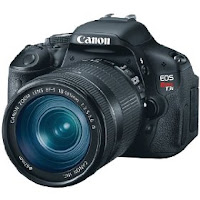
Canon EOS 700D is essentially identical to the 650D, making this the least distinct upgrade we've seen in this range of cameras. Elements carried over include the 18MP CMOS sensor, a 9-point cross-type AF sensor, 3-inch, a 1.04m-dot vari-angle LCD screen, and Full HD video mode. Its Hybrid AF system was also brought over from the 650D, and while the simultaneously announced 100D/Rebel SL1's Hybrid AF II covers a wider area than the one here, neither is said to be any faster than the rather slow implementation on the 650D.
The EOS 700D, like the 650D before it and the EOS 100D announced alongside, features a touchscreen. The screen is capacitative rather than resistive, meaning that like the now-ubiquitous smartphone, it's sensitive to contact rather than pressure and capable of interpreting more complex user input. In Live View and Movie modes the screen can be used to specify the point of focus and release the shutter, as we've seen before on several mirrorless cameras. It also supports multi-touch and gestures, meaning that it offers phone-like pinch-to-zoom and image-to-image swiping in playback. The results is a user experience that smartphone users will immediately find familiar.
Canon EOS 700D / Rebel T5i key features
Canon EOS 700D / Rebel T5i key features
- 18MP APS-C 'Hybrid CMOS' sensor
- Phase-detection AF from imaging sensor for Live View and Video
- Continuous autofocus in movie mode with subject tracking
- New 18-55mm STM kit lens with stepper motor for improved live view/video autofocus
- 14-bit DIGIC 5 processor
- ISO 100-12800 standard, 25600 expanded
- 5 fps continuous shooting
- 9 point AF system, all sensors cross type, central sensor F2.8 (from 60D)
- 63 zone iFCL metering
- 1080p30 video recording, stereo sound with internal or external mics
- 1.04m dot 3:2 touch-sensitive vari-angle ClearView II LCD (capacitative type, multi-touch support)




















